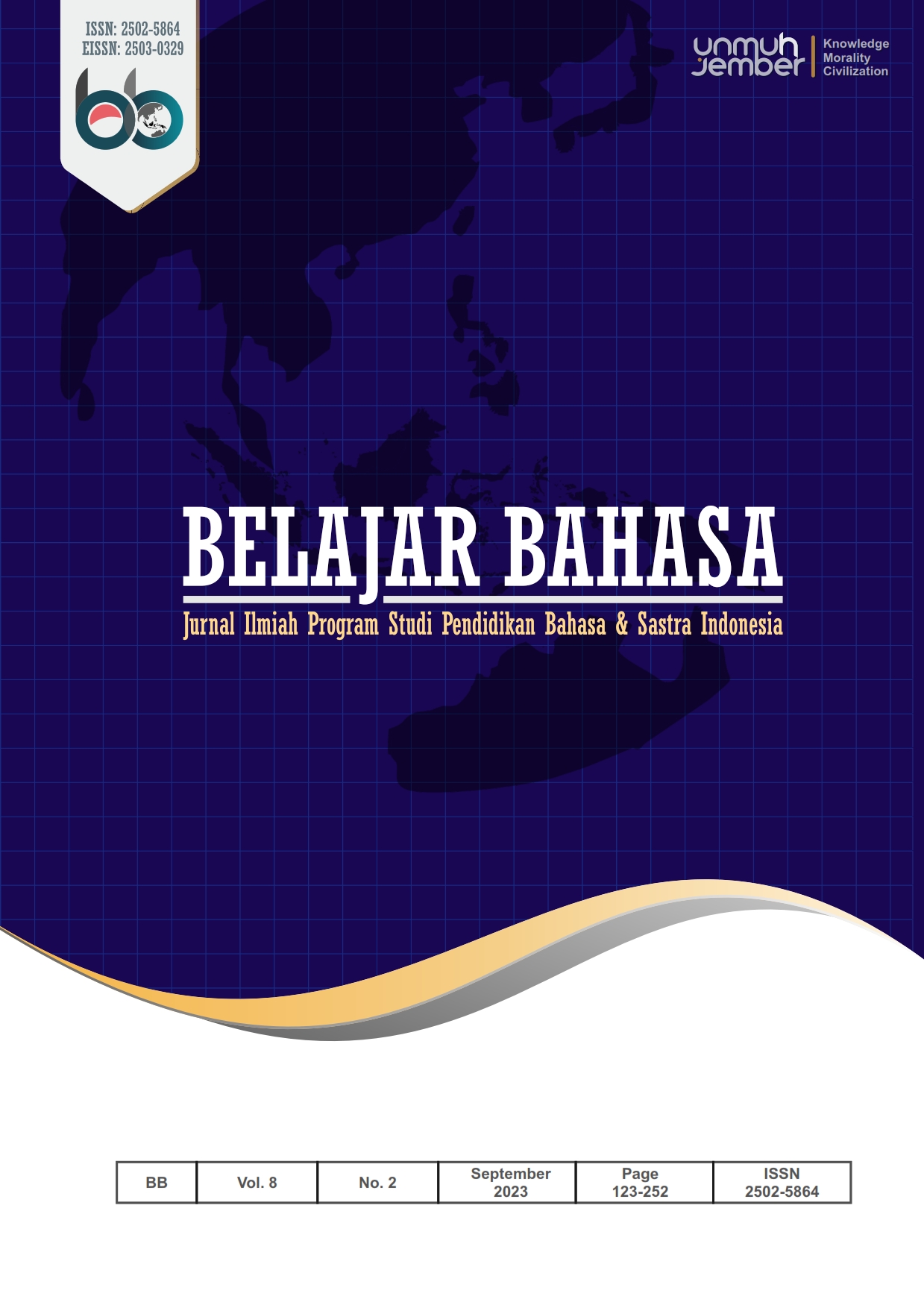Strategi Belajar Bahasa Indonesia Siswa SMA Di Kota Padang Dalam Penerapan Kurikulum Merdeka
DOI:
https://doi.org/10.32528/bb.v8i2.914Kata Kunci:
Kata kunci: Strategi Belajar Bahasa Indonesia; Kurikulum Merdeka.Abstrak
This study aims to describe the types of learning strategies used by students in learning language. Differentiated based on direct strategies (cognitive strategies, memory strategies, and completion strategies) and indirect strategies (metacognitive strategies, affective strategies, and social strategies). This type of research is in the form of quantitative and survey methods. A total of 272 high school students in the city of Padang were given questionnaires to collect strategies used by students in learning Indonesian. Data analysis techniques using descriptive and factor analysis. Descriptive analysis to calculate the percentage of learning strategies used by students. Factor analysis is used to determine the most dominant strategy used by students. The results of the data analysis showed that the students used the most dominant cognitive strategy. The independent curriculum encourages students to develop critical and creative thinking skills. The results of the study show that students from the same city as Padang use direct and indirect strategies. Students use cognitive strategies 80.2%. Students use 83% memory. Students use the 85% recovery strategy. Students use metacognitive strategies 82.1%. Students use affective strategies 86.4%. Students use social strategies 83%. After the factor test was carried out, it was found that the most dominant strategy was used by cognitive students, namely. In implementing the independent curriculum at Padang City High School specifically in learning Indonesian. Cognitive strategies used by students to respond to the pedagogical genre used by the teacher. Students use cognitive strategies, construct contexts, write together and independently
Referensi
REFERENSI
Ariin, D. Z., & Pd, M. (2012). Evaluasi Pembelajaran. www.diktis.kemenag.go.id
Khoirurrijal, Fadriati, Sofia, Makrufi, A. D., Gandi, S., Muin, A., Tajeri, Fakhrudin, A., Hamdani, & Suparno. (2022). PENGEMBANGAN KURIKULUM MERDEKA (Z. R. Bahar & R. Aqli (eds.); 1st ed.). CV. Literasi Nusantara Abadi.
Konteks, D., Belajar, M., Azis, F., Pd, M., B, M. G., Pembelajaran, S., Konteks, D., & Belajar, M. (n.d.). Strategi pembelajaran.
Natshia, H., & Abadi, M. (2022). Analisis strategi guru bahasa indonesia dalam implementasi kurikulum merdeka. Basastra: Jurnal Kajian Bahasa Dan Sastra Indonesia, 11(3), 227–245.
Nur Amalia, M. (2018). Penggunaan strategi kognitif mahasiswa critical language scholarship 2018 pada keterampilan berbicara. Strategi Kognitif Mengacu Pada Cara-Cara Atau Trik-Trik Guna Memecahkan Masalah Pada Penyelesaian Tugas., 3(12), 1624–1631. https://www.mendeley.com/viewer/?fileId=57e3aac5-392d-5131-1e81-92dc1cc717fe&documentId=e95ded1f-bc89-3706-a4ea-7bff4bd957c2
Oxford, R. L. (1990). LANGUAGE LEARGNING STRATEGIES (1st ed.). Heinle & Heinle.
Ramadhanti, D., & Yanda, D. P. (2022). Pembelajaran Menulis Teks: Suatu Pendekatan Salah satu daya tarik utama indohoki77
adalah antarmuka yang dirancang dengan baik dan mudah digunakan Kognitif (Edisi Pertama (ed.)). Grup Penerpitan CV Budi Utama.
Siyamta. (2013). Ranah Kognitif Dalam Pembelajaran Mata Kuliah : Teori Dan Model Dalam TEP.
Sugiyono. (2014). Cara Mudah Menyusun: Skripsi (Doctoral dissertation, Tesis, dan Disertasi (M. Apri Nuryanto, S.pd.,ST. (ed.); Cetakakan). ALFABETA,cv.
Yanda, D. P., & Ramadhanti, D. (2022). Measuring Online Learning Strategies During The Covid-19 Pandemic: Instrument Validity and Reliability. Bahastra, 42(1), 58–72. https://doi.org/10.26555/bs.v42i1.69
Unduhan
Diterbitkan
Cara Mengutip
Terbitan
Bagian
Lisensi
Hak Cipta (c) 2023 BELAJAR BAHASA: Jurnal Ilmiah Program Studi Pendidikan Bahasa dan Sastra Indonesia

Artikel ini berlisensi Creative Commons Attribution 4.0 International License.






